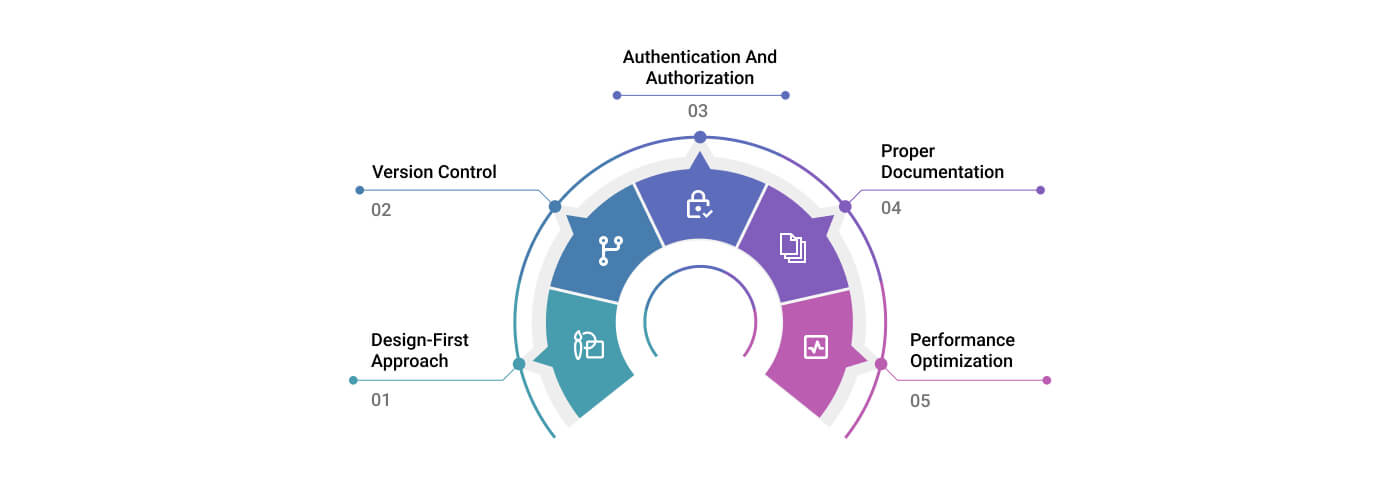 By Jophin
January 12, 2024
3 min read
By Jophin
January 12, 2024
3 min read
Top 5 best practices for seamless API development
As a business owner, you might be aware that effective software and product development have been utterly based on APIs. Therefore, APIs play an essential role in building applications and software. For seamless communication between applications, you need to develop well-structured Application Programming Interfaces. Undoubtedly, leveraging the best API development service in Australia will empower you to create optimal customer and digital experiences for your business.
Furthermore, Application Programming Interfaces (APIs) have become the backbone of modern applications and products. Developing APIs enables different software systems to communicate and share data without hassle. As businesses increasingly rely on interconnected services, the importance of robust API development cannot be overstated.
However, dealing with many protocols, formats, and security concerns makes API integration a difficult task for developers and product owners. To guarantee a fruitful Application Programming Interface development and integration for your business, it is paramount to pursue the best practices.
In this blog, we will explore the fundamentals of API development and delve into the top five best practices to ensure a smooth and efficient API development process. Also, we will cover some essential aspects of API creation and integration.
Let us begin with…
What is API development?
API development involves creating a set of rules and protocols that allow different software applications to communicate with each other without any interruptions. It serves as a bridge between different components, which enables them to interact and share information. Let us give an instance for your better understanding. Consider APIs as a waiter taking orders from customers (applications) and conveying them to the kitchen (server), which brings back the requested dishes (data).
Furthermore, APIs provide a standardized way for applications to request and share information, which makes it possible for your developers to integrate various services seamlessly. As a business owner or a product manager, you can utilize API for a wide range of purposes, such as retrieving data from a server, sending data to a server, or accessing specific features of an application.
In addition, they are fundamental in enabling the integration of different services, applications, or platforms, which encourages collaboration in product development. Integrating or developing API typically involves defining the specifications of the API, including details about endpoints, data formats (how data is structured and exchanged), and authentication methods. That is why API development is a crucial aspect of software architecture, which empowers businesses to build scalable systems that can adapt to changing requirements and technological advancements.
Importance of API integration in business
API integration plays a crucial role in the success of your business in your target marketplace. It facilitates seamless communication between diverse software systems, which leads to increased efficiency, enhanced user experiences, and accelerated innovation.
If you are a business owner or CXO of a company, then incorporating APIs will help you unlock the potential to connect with third-party services, streamline internal processes, and expand your digital reach globally. This interoperability is crucial in today’s digital ecosystem, as applications often rely on data and functionalities from various sources.
Effective API development can lead to improved customer satisfaction by providing a unified experience across different platforms. For instance, your mobile application can seamlessly retrieve user data from a backend server, which ensures a consistent experience regardless of the device used.
Additionally, APIs empower your business to stay agile and responsive to market demands by enabling quick adaptation and integration of new technologies.
Best 5 practices for effective API development
For building robust and scalable Application Programming Interfaces, you need to follow some ideal practices for effective API creation and integration. Here we list the top five best practices that your developers need to consider for developing APIs.

-
Design-first approach
Developing a successful API lies in its design. As a business owner, you need to adopt a design-first approach which involves defining the API’s specifications before the actual development begins. This includes outlining the endpoints, data formats, and authentication methods. Tools like Open API Specification (OAS) or RAML can assist in creating a clear and comprehensive Application Programming Interface design.
By focusing on a design-first approach, your development teams can ensure that the API follows industry best practices. It also facilitates collaboration between different teams, such as developers and stakeholders, which ensures that everyone has a shared understanding of the API’s purpose and functionality.
-
Version control
APIs are dynamic entities that evolve to meet changing requirements. Implementing version control is essential to manage these changes effectively. Each release of an API should have a unique version number, which allows your developers to track and adapt to modifications without disrupting existing integrations.
Versioning also provides backward compatibility, which ensures that older versions of the API remain functional even as newer iterations are introduced. This approach prevents unexpected disruptions for users relying on the API. So, it fosters a stable and reliable integration environment.
-
Authentication and authorization
Security is a paramount concern in API development, and implementing robust authentication and authorization mechanisms is indispensable. Enabling secure APIs ensures that only authorized users or applications can access sensitive data or perform specific actions.
OAuth 2.0, API keys, and JSON Web Tokens (JWT) are common authentication methods leveraged by most API developers for secure integration. Additionally, incorporating role-based access control (RBAC) enables fine-grained control over what actions different users or applications can perform. By prioritizing security, your API developers can mitigate potential vulnerabilities.
-
Proper documentation
Comprehensive and user-friendly documentation is the backbone of any successful API development. If developers want to interact with an API, then they might need clear instructions on how to use its endpoints, what data to expect, and any potential error scenarios. Well-documented APIs reduce the learning curve for developers, which accelerates the integration process.
Popular documentation formats include Swagger and API Blueprint. Including code examples, sample requests, and responses will enhance the documentation’s practical value. Regularly updating documentation to reflect changes in the API ensures that developers always have accurate information.
-
Performance optimization
Optimizing API performance is crucial for providing a responsive and reliable experience to users. This involves minimizing response times, reducing latency, and efficiently managing resources on both the client and server sides. Load balancing, caching mechanisms, and asynchronous processing can significantly contribute to performance improvements.
Furthermore, regularly monitoring and profiling the API helps identify bottlenecks and areas for improvement. Conducting load testing under different conditions ensures that the API can handle varying levels of traffic. Investing in performance optimization not only enhances user satisfaction but also contributes to the overall scalability of the API.
As businesses continue to leverage APIs for efficiency, following these five best practices will pave the way for a robust API ecosystem. Next, let us see.
Limitations of API development
Integrating APIs will offer a cluster of benefits for your business. However, it’s essential to be aware of their limitations. Here we list a few limitations of API integration and development.
- One of the significant challenges is the potential for security vulnerabilities if proper authentication and authorization measures are not in place.
- Additionally, changes to the API can impact existing integrations, which makes version control crucial. The risk of over-reliance on external APIs leads to potential disruptions if the external service undergoes changes.
- The rapid evolution of technology may render certain API versions obsolete, which necessitates continuous updates and maintenance.
- Lastly, managing the documentation and ensuring it stays updated can be time-consuming but is essential for a successful API implementation.
These are major limitations of APi creation and integration.
Wrapping up
Effective and seamless API development is indispensable for businesses seeking to thrive in a connected digital ecosystem. By adopting a design-first approach, prioritizing authentication, and other best practices, your development teams can ensure the seamless integration of APIs. Understanding the limitations of API development is equally crucial, which prompts you to approach API development with a strategic mindset and a commitment to ongoing maintenance and improvement.
If you are a business leader or a product owner planning to design and integrate secure APIs for your product, then connecting with Fortunesoft is the smart decision. We help your business to scale with robust APIs and integrate them into your business swiftly. By hiring API developers from Fortunesoft, you can build rich and secure APIs that work seamlessly across all applications.
Author Bio


 Facebook
Facebook Whatsapp
Whatsapp LinkedIn
LinkedIn Pinterest
Pinterest






 Start Chat
Start Chat